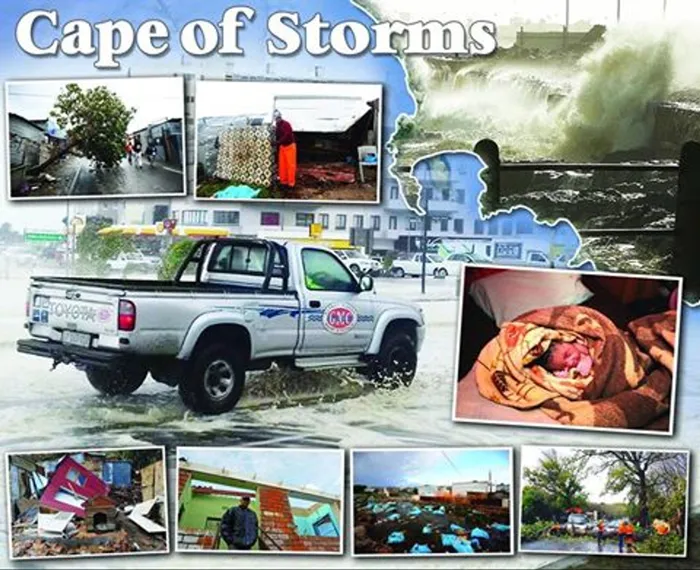Rampaging storm, fire claim eight lives

A storm and fire claimed eight lives in the Western Cape yesterday.
Lightning during the storm set alight a home in Kraaifontein in the morning, killing 4-year-old twins and two adults aged 40 and 48.
As winds of up to 90km/h howled through the peninsula, an unfinished building collapsed onto a Wendy house in Lavender Hill, killing 69-year-old Joseph Connie instantly.
The man’s family said his body had been stuck under rubble for three hours before forensics arrived.
In Rheenendal, Knysna, a farmworker, his wife and their son died when a fire broke out in the area.
In Lavender Hill, Connie’s distraught wife said she was battling to come to terms with the incident.
“I wasn’t here when it happened, I’m hearing things from everyone,” she said.
Connie’s nephew, Jody Africa, 19, was in the house when he heard a loud noise.
He saw the roof collapse on his uncle. “It went ‘gwah’ and then the roof fell,” said Africa, who sustained minor injuries.
In George, the wind wreaked havoc again, blowing the roofs off 32 shacks.
In Kannaland, 40 people were evacuated after houses lost their roofs.
More than 2 000 were left displaced in “greater Cape Town” yesterday, said James-Brent Styan, the spokesperson for Western Cape Local Government MEC Anton Bredell.
“More than 2 000 residents of Imizamo Yethu, in the South Peninsula, required alternative emergency accommodation, plus the residents of 200 homes in Makhaza, Khayelitsha.
“More than 80 people from an informal settlement in Villiersdorp were evacuated owing to rising water levels,” Styan said.
He said in Grabouw, roofs in informal settlements were blown off and road closures were reported in the area.
Six informal dwellings were affected in Botriver and six families were displaced and assisted by authorities.
“More than 100 adults and children were evacuated from homes in Franschhoek, while emergency services were also assessing the situation in Touw’s River,” he said.
Three multicar pile-ups were reported, and power outages across the metro left thousands in the dark.
Residents were encouraged to stay indoors and steer clear of coastal areas, as the storm coincided with a spring tide, resulting in massive swells.
The SA Air Force (SAAF) Oryx helicopter was on emergency-standby to assist with evacuations.
The South African Red Cross Society assisted, providing humanitarian relief.
Other city departments cleared uprooted trees and other blockages that occurred as a result of the rain and gale-force winds
Chapman’s Peak was closed because of mudslides, and while the Huguenot Tunnel was open to cars, heavier vehicles were rerouted through the Du Toit’s Kloof Pass.
The South African National Roads Agency (Sanral) said by noon, emergency teams responded to three multivehicle crashes and assisted 13 stranded vehicles.
Sanral engineering manager Randall Cable, said 239 CCTV cameras monitored more than 160km of the busiest freeways around Cape Town.
Provincial Education MEC Debbie Schäfer’s spokesperson, Jessica Shelver, said seven schools reported incidents of storm damage.
Schools and universities were closed yesterday as a safety precaution.
“Severe damage to the school roof at two schools, water damage to classrooms and damage to fences were reported,” Shelver said.
Schools in the province will reopen today.
The SA Weather Service said that the cold front was expected to persist today.
Small stock farmers were advised that heavy rain leading to flooding, snowfalls and very cold conditions was expected.
Sea swells between 6m and 12m are expected, and wind speeds may reach up to 90km/* .
Forecaster Michael Barnes confirmed that since Tuesday evening, the storm brought in between 10mm and 30mm of rainfall, and between 40mm and 60mm in mountainous areas. About 80mm was reported in the Grabouw area.